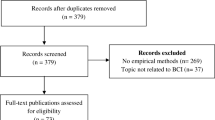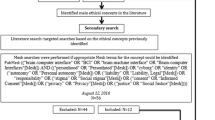Abstract
Brain Computer Interface (BCI) technology offers potential for human augmentation in areas ranging from communication to home automation, leisure and gaming. This paper addresses ethical challenges associated with the wider scale deployment of BCI as an assistive technology by documenting issues associated with the development of non-invasive BCI technology. Laboratory testing is normally carried out with volunteers but further testing with subjects, who may be in vulnerable groups is often needed to improve system operation. BCI development is technically complex, sometimes requiring lengthy recording sessions to achieve the necessary personalisation of the paradigms, and this can present ethical challenges that vary depending on the subject group. The paper contributes to the on-going ethical discussion surrounding the deployment BCI outside the specialist laboratory and suggests some tentative guidelines for BCI research teams, appropriate to those deploying the technology, derived from experience on a multisite project. Any tension between deployment and technical progress must be managed by a formal process within a multidisciplinary consortium.


Similar content being viewed by others
References
Beauchamp, T.L., Childress J.F. (2009), Principles of Biomedical Ethics. Oxford University Press, Inc.
Obama proposes brain mapping project (2013). http://www.bbc.co.uk/news/science-environment-22007007, accessed April 2013.
Nuffield Council on Bioethics (2012). Novel neurotechnologies: intervening in the brain, http://www.nuffieldbioethics.org/neurotechnology, accessed April 2013.
Farah M.J. (2011). Neuroscience and neuroethics in the 21st century. In J. Illes and B.J. Sahakian (Eds.) The Oxford Handbook of Neuroethics. Oxford University Press.
Vlek, R.J., D. Steines, D. Szibbo, A. Kübler, M.J. Schneider, P. Haselager, et al. 2012. Ethical issues in Brain–Computer interface research, development, and dissemination. Journal of Neurologic Physical Therapy 36(2): 94.
FP7-BRAIN project (2012), http://www.brain-project.org, accessed April 2013.
McCullagh P. J., Ware M., Mulvenna M., Lightbody G., Nugent C. D., & McAllister H. G. (2010). Can Brain Computer Interfaces Become Practical Assistive Devices in the Community? In: Medinfo 2010, Cape Town, IOS Press. 5 pp.
University of Ulster Research Governance, http://research.ulster.ac.uk/rg/, accessed April 2013.
Graimann B., Allison B., and Pfurtscheller G. (2010) Brain–Computer Interfaces: A Gentle Introduction in B. Graimann et al. (eds.), Brain–Computer Interfaces, The Frontiers Collection, DOI 10.1007/978-3-642-02091-9_1, Springer-Verlag Berlin Heidelberg.
Millán J.R., Rupp R., Müller-Putz G., Murray-Smith R., Giugliemma C., Tangermann M., Vidaurre C., Cincotti F., Kübler A. & Leeb R. (2010), Combining Brain–Computer Interfaces and Assistive Technologies: State-of-the-Art and Challenges, Frontiers in Neuroscience, vol 4, article 161, p1-15, 2010.
Wolpaw, J.R., N. Birbaumer, D.J. McFarland, G. Pfurtscheller, and T.M. Vaughan. 2002. Brain–computer interfaces for communication and control. Clinical Neurophysiology 113: 767–791.
Nijholt A., Reuderink B. & Oude Bos D. (2009), Turning shortcomings into challenges: Brain-computer interfaces for games, Intelligent Technologies for Interactive Entertainment, Springer, pp. 153–168
Sellers, E.W., T.M. Vaughan, and J.R. Wolpaw. 2010. A brain-computer interface for long-term independent home use. Amyotrophic Lateral Sclerosis 11: 449–455.
Buch, E., C. Weber, L.G. Cohen, C. Braun, M.A. Dimyan, T. Ard, J. Mellinger, A. Caria, S. Soekadar, A. Fourkas, and N. Birbaumer. 2008. Think to move: A neuromagnetic brain-computer interface (BCI) system for chronic stroke. Stroke 39: 910–917.
Pineda, J., D. Brang, E. Hecht, L. Edwards, S. Carey, M. Bacon, C. Futagaki, D. Suk, J. Tom, C. Birnbaum, and A. Rork. 2008. Positive behavioral and electrophysiological changes following neurofeedback training in children with autism. Res Autism Spect Disord 2: 557–581.
Zander, T.O., M. Gaertner, C. Kothe, and R. Vilimek. 2011. Combining Eye Gaze Input With a Brain-Computer Interface for Touchless Human-Computer Interaction. Int. J. Hum-Comput. Int. 27: 38–51.
Prentice S. and Fenn J., Hype cycle for human-computer interaction: Gartner, 2011
British Psychological Society (2004), Guidelines for minimum standards of ethical approval in psychological research, http://www.bps.org.uk/what-we-do/ethics-standards/ethics-standards, accessed April 2013.
Faden RR, Beauchamp TL, King NM (1986) A history and theory of informed consent. Oxford University Press on Demand
Clausen, J. 2009. Man, machine and in between. Nature 457(26): 1080–1081.
Wolpe P.R., (2007) Ethical and social challenges of brain-computer interfaces. Virtual Mentor 9:128–131. http://virtualmentor.ama-assn.org/2007/02/msoc1-0702.html, accessed April 2013.
Nijboer F. and Broermann U. (2010) Brain-Computer Interfaces for Communication and Control in Locked-in Patients, In Eds: B. Graimann, G. Pfurtscheller, B. Allison: Brain-Computer Interfaces, pp185-201, Springer Berlin Heidelberg 2010.
Allison, B. (2011), Future BNCI Roadmap, http://future-bnci.org/images/stories/Future_BNCI_Roadmap.pdf, accessed April 2013.
Tamburrini, G. 2009. Brain to computer communication: Ethical perspectives on interaction models. Neuroethics 2(3): 137–149.
Unesco Chair in Bioethics (2003). Informed Consent, http://www.unesco-chair-bioethics.org/UI/F0101.aspx?uid=F8CC42FAE5B3EDA4, accessed April 2013.
Kübler, A., and N. Birbaumer. 2008. Brain-computer interfaces and communication in paralysis: Extinction of goal directed thinking in completely paralysed patients? Clinical Neurophysiology 119(11): 2658–2666.
Haselager, P., R. Vlek, J. Hill, and F. Nijboer. 2009. A note on ethical aspects of BCI. Neural Networks 22: 1352–1357.
Nijboer, F., Clausen, J., Allison B. Z., & Haselager P. (2011a), The asilomar survey: Stakeholders’ opinions on ethical issues related to brain-computer interfacing. Neuroethics,, 1–38
Allison, B. (2011), Trends in BCI research: progress today, backlash tomorrow? Crossroads, The ACM Magazine for Students - Neuroscience and Computing: Technology on the Brain, Vol 18 (1), 18–22, 2011. ACM New York
Leigh R. Hochberg, Kim D. Anderson (2012), BCI Users and Their Needs. In: J. Wolpaw and E. Winter Wolpaw (Eds.) Brain–Computer Interfaces: Principles and Practice. Oxford Scholarship Online: May 2012 DOI:10.1093/acprof:oso/9780195388855.003.0019
Grübler G. (2011), Beyond the responsibility gap. discussion note on responsibility and liability in the use of brain-computer interfaces. AI & Society,, 1–6.
Farah, M.J. 2012. Neuroethics: The Ethical, Legal and Societal Impact of Neuroscience. Annual Review of Psychology 63: 571–591.
ABC news (2013), Day’s brain training boosts his golf form, http://www.abc.net.au/news/2013-03-06/days-brain-training-boosts-his-golf-form/4555902, accessed April 2013.
Nijboer, F., J. Clausen, B.Z. Allison, and P. Haselager. 2011. Researchers’ opinions about ethically sound dissemination of BCI research to the public media. International Journal of Bioelectromagnetism 13(3): 108–109. International Society for Bioelectromagnetism.
Volosyak, I., D. Valbuena, T. Lüth, T. Malechka, and A. Gräser. 2011. BCI Demographics II: How Many (and What Kinds of) People Can Use a High-Frequency SSVEP BCI? IEEE Transactions on Neural Systems and and Rehabilitation Engineering 19(3): 232–239.
Neuper C., Pfurtscheller G. (2010), Electroencephalographic characteristics during motor imagery. In A. Guillot and C. Collet (eds.): The neurophysiological foundations of mental and motor imagery (Chapter 2), Oxford 2010.
Cedar Foundation (2013), http://www.cedar-foundation.org/, accessed April 2013.
TMSI http://www.tmsi.com, accessed April 2013.
Volosyak, I., D. Valbuena, T. Malechka, J. Peuscher, and A. Gräser. 2010. Brain-computer Interface Using Water-based Electrodes. Journal of Neural Engineering 7: 066007.
Garcia-Molina, G., and V. Mihajlovic. 2010. Spatial filters to detect Steady State Visual Evoked Potentials elicited by high frequency stimulation: BCI application. Journal of Biomedizinische Technik/Biomedical Engineering 3(55): 173–182.
Kus, R., D. Valbuena, J. Zygierewicz, T. Malechka, A. Graser, and P. Durka. 2012. Asynchronous BCI based on motor imagery with automated calibration and neurofeedback training. IEEE Transactions on Neural Systems and and Rehabilitation Engineering 20(6):823–35.
Blain-Moraes, S., R. Schaff, K.L. Gruis, J.E. Huggins, and P.A. Wren. 2012. Barriers to and mediators of brain–computer interface user acceptance: Focus group findings. Ergonomics 55(5): 516–525.
Bauby JD (1988) The diving bell and the butterfly: A memoir of life in death. Jeremy Leggatt (Translator), Vintage Books; 1st Vintage International edition
BBC news website (2013) Nicklinson case is about ‘right to kill’, says Royal College of Physicians, http://www.bbc.co.uk/news/health-19287568, accessed April 2013.
Intendix. (www.intendix.com), accessed April 2013.
Brain Communication Foundation (2013), www.braincommunication.org/index.php, accessed April 2013.
Lightbody G., Ware M., McCullagh P., Mulvenna M., Thomson E., Martin S. (2010), A user centred approach for developing brain-computer interfaces. Pervasive Computing Technologies for Healthcare (Pervasive Health), 2010 4th International Conference on-, pp. 1-8.
Ware, M.P., McCullagh, P.J., McRoberts, A., Lightbody, G., Nugent, C.D., McAllister, G. Mulvenna, M. D. 2010. Contrasting levels of accuracy in command interaction sequences for a domestic brain-computer interface using SSVEP. Biomedical Engineering Conference (CIBEC), 2010 5th Cairo International, 150-153
Hildz E., (2009), Ethical and legal aspects of direct brain-computer-interaction in present research and future application (personal communication).
Ehlers, J., I. Volosyak, and T. Lüth. 2010. Toward a BCI Wizard. In Methods and applications in automation, ed. A. Gräser and D. Ristic-Durrant, 65–73. Aachen: Shaker Verlag.
Illes, J., M.P. Kirschen, E. Edwards, L.R. Stanford, P. Bandettini, M.K. Cho, P.J. Ford, G.H. Glover, J. Kulynych, R. Macklin, D.B. Michael, and S.M. Wolf. 2006. Incidental Findings in Brain Imaging Research: What should happen when a researcher sees a potential health problem in a brain scan from a research subject? Science. 311(5762): 783–784.
Back Home http://www.backhome-fp7.eu/ Brain-neural computer interfaces on track to home – Development of a practical generation of BNCI for independent home use, accessed April 2013.
Author information
Authors and Affiliations
Corresponding author
Rights and permissions
About this article
Cite this article
McCullagh, P., Lightbody, G., Zygierewicz, J. et al. Ethical Challenges Associated with the Development and Deployment of Brain Computer Interface Technology. Neuroethics 7, 109–122 (2014). https://doi.org/10.1007/s12152-013-9188-6
Received:
Accepted:
Published:
Issue Date:
DOI: https://doi.org/10.1007/s12152-013-9188-6




